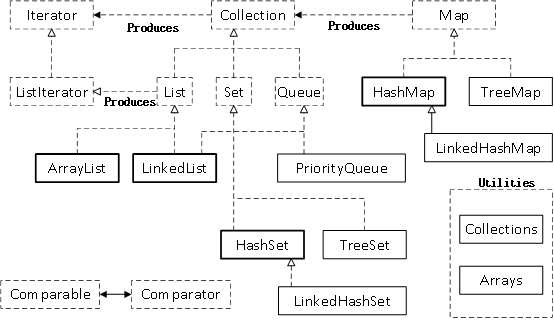(1)Collection。一个独立元素的序列,这些元素都服从一条或多条规则。List必须按照插入的顺序保存元素;Set不能有重复元素;Queue按照排队规则来确定对象产生的顺序。
(2)Map。一组成对的“键值对”对象,允许你使用键来查找值。ArrayList允许你使用数字来查找值。
(1)Arrays.asList()方法接受一个数组或是一个用逗号分隔的元素列表,并将其转换为一个List对象。
1 Collection<Integer> collection = new ArrayList<Integer>(Arrays.asList(1,2,3,4,5,6));
2 Integer[] moreInts = {7,8,9};
3 collection.addAll(Arrays.asList(moreInts));
4 List<Integer> list = Arrays.asList(16,17,18);
(2)Collections.addAll()方法接受一个Collection对象,以及一个数组或是一个用逗号分割的列表,将元素添加到Collection中。
1 Collections.addAll(collection,10,11,12);
2 Collections.addAll(collection,moreInts);
(3)Collection的addAll()成员方法,只能接受另一个Collection对象作为参数。
1 Integer[] moreInts = {7,8,9};
2 collection.addAll(Arrays.asList(moreInts));
List可以将元素维护在特定的序列中。
(1)ArrayList:类似顺序表,可以随机访问元素,插入和移除元素时较慢。
(2)LinkedList:链表,提供了优化的顺序访问,插入和删除操作代价小。
| 方法名 | 作用 |
|---|---|
| subList(1,3) | 从较大列表中截取序号从1到3的元素生成一个新列表(包括索引值为1的元素,不包括索引值为3的元素) |
| Collection.shuffle() | 随机打乱一个顺序数组 |
| retainAll() | 一种有效的“交集”操作 |
LinkedList和ArrayList一样实现了基本的List接口,但是它执行在List中间插入和移除时比ArrayList更高效,但在随机访问操作方面却要逊色一些。
| 方法名 | 作用 |
|---|---|
| getFirst() | 返回列表的头;List为空时抛出NoSuchElementException |
| element() | 返回列表的头;List为空时抛出NoSuchElementException |
| peek() | 返回列表的头;List为空时返回null |
| removeFirst() | 移除并返回列表的头;List为空时抛出NoSuchElementException |
| remove() | 移除并返回列表的头;List为空时抛出NoSuchElementException |
| removeLast() | 移除并返回列表的最后一个元素 |
| poll() | 移除并返回列表的头;List为空时返回null |
| addFirst() | 将某个元素插入到列表的头部 |
| add() | 将某个元素插入到列表的尾部 |
| addLast() | 将某个元素插入到列表的尾部 |
“栈”通常是指“后进先出”(LIFO)的容器。
1 public class Test {
2 ?
3 public static void main(String[] args) {
4 Stack<String> stack = new Stack<String>();
5 for(String s:"I am a clever boy".split(" ")){
6 stack.push(s);
7 }
8 while(!stack.isEmpty()){
9 System.out.print(stack.pop() + " ");
10 }
11 }
12 }
Set不保存重复的元素。Set具有与Collection完全一样的接口。
(1)HashSet。使用了散列,输出的顺序没有任何规律可循。
(2)TreeSet。将元素存储在红-黑树数据结构中,按照比较结构的升序保存对象。
(3)LinkedHashSet。它按照添加的顺序保存对象。
Map保存了一组键值对,例如<key,value>。
| 方法名 | 作用 |
|---|---|
| put(key,value) | 保存键值对 |
| get(key) | 获取对应的value |
| containsKey() | 是否有相应的key |
| containsValue() | 是否有相应的value |
| keySet() | 获取所有的key |
队列是一个典型的先进先出(FIFO)的容器。即从容器的一端放入事物,从另一端取出,并且事物放入容器的顺序与取出的顺序是相同的。通过offer()方法将一个元素插入到队尾,通过remove()方法读取队头元素。
PriorityQueue。优先级队列声明下一个弹出元素是最需要的元素(具有最高的优先级)。
迭代器是一个对象,它的工作是遍历并选择序列中的对象。迭代器通常被称为轻量级对象:创建它的代价小。
(1)Iterator。只能单向移动。使用iterator()方法要求容器返回一个Iterator。使用next()获取下一个元素。使用hasNext()检查序列中是否还有元素。使用remove()将迭代器近返回的元素删除。
1 public class Test {
2 public static ArrayList<Integer> listofRandInteger(int length, int n)
3 {
4 Random rand = new Random();
5 ArrayList<Integer> li = new ArrayList<Integer>();
6 for(int i = 0; i < length; i++)
7 li.add(rand.nextInt(n));
8 return li;
9 }
10 ?
11 public static void display(Iterator<Integer> it){
12 System.out.print("[");
13 while (it.hasNext()){
14 Integer i = it.next();
15 System.out.print(i + " ");
16 }
17 System.out.println("]");
18 }
19 ?
20 public static void main(String[] args) {
21 ArrayList<Integer> al = (ArrayList<Integer>) listofRandInteger(6,10);
22 LinkedList<Integer> ll = new LinkedList<Integer>(al);
23 HashSet<Integer> hs = new HashSet<Integer>(al);
24 TreeSet<Integer> ts = new TreeSet<Integer>(al);
25 display(al.iterator());
26 display(ll.iterator());
27 display(hs.iterator());
28 display(ts.iterator());
29 }
30 }
(2)ListIterator。一个更加强大的Iterator的子类型,它只能用于各种List类型的访问,可以双向移动。使用listIterator()方法返回一个指向List开始处的ListIterator。使用listIterator(n)方法返回一个一开始就指向列表索引为n的元素处的ListIterator。
1 public class Test {
2 public static ArrayList<Integer> listofRandInteger(int length, int n)
3 {
4 Random rand = new Random();
5 ArrayList<Integer> li = new ArrayList<Integer>();
6 for(int i = 0; i < length; i++)
7 li.add(rand.nextInt(n));
8 return li;
9 }
10 ?
11 ?
12 public static void main(String[] args) {
13 List<Integer> al = listofRandInteger(6,10);
14 ListIterator it = al.listIterator();
15 while (it.hasNext()){
16 System.out.print(it.next() + ",next:" + it.nextIndex() + ",previous:" + it.previousIndex() + "; ");
17 }
18 System.out.println("");
19 while (it.hasPrevious()){
20 System.out.print(it.previous() + " ");//将序列倒序输出
21 }
22 System.out.println("");
23 System.out.println(al);
24 it = al.listIterator(3);
25 int i = 0;
26 while (it.hasNext()){
27 it.next();
28 it.set(i++);
29 }
30 System.out.println(al);
31 }
32 }

参考于《Java编程思想》,第216~247页
原文:https://www.cnblogs.com/yqsumAll/p/14846416.html